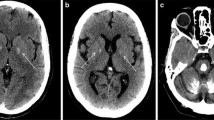Abstract
Primary familial brain calcifications (PFBC) compose a rare neurologic condition characterized by a bilateral pattern of hydroxyapatite deposits in basal ganglia, dentate nuclei, and thalamus. PFBC is identified through neuroimaging screenings such as computerized tomography. Patients with PFBC might present a wide variety of neurological symptoms such as mental and motor impairments, often misdiagnosed as Parkinson’s disease, schizophrenia, Alzheimer’s disease, and migraine. Four genes were confirmed as causative of PFBC: SLC20A2, PDGFB, PDGFRB, and XPR1. Curiously, other studies made occasional links between XPR1 variations or expression changes, in a few neuropsychiatric models. This letter is an assembly on XPR1 variants and expression change pattern data that were published in recent scientific reports, even before the current connection between that gene and brain calcification.
Similar content being viewed by others
References
Battini JL, Rasko JEJ, Miller AD (1999) A human cell-surface receptor for xenotropic and polytropic murine leukemia viruses: possible role in G protein-coupled signal transduction. Proc Natl Acad Sci U S A 96:1385–90. doi:10.1073/pnas.96.4.1385
Fujioka Y, Ishigaki S, Masuda A, Iguchi Y, Udagawa T, Watanabe H, Katsuno M, Ohno K, Sobue G (2013) FUS-regulated region-and cell-type-specific transcriptome is associated with cell selectivity in ALS/FTLD. Sci Rep 3:2388. doi:10.1038/srep02388
Gianchelli CM, Jono S, Shioi A, Nishizawa Y, Mori K, Morii H (2001) Vascular calcification and inorganic phosphate. Am J Kidney Dis 38(4):S34–37
Giovannini D, Touhami J, Charnet P, Sitbon M, Battini JL (2013) Inorganic phosphate export by the retrovirus receptor XPR1 in metazoans. Cell Rep 3:1866–1873
Keller A, Westenberger A, Sobrido MJ, García-Murias M, Domingo A, Sears RL, Lemos RR, Ordogñez-Ugalde A, Nicolas G, Cunhas JEG, Rushing EJ, Hugelshofer M, Wurnig MW, Kaech A, Reimann R, Lohmann K, Dobricic V, Carracedo A, Petrovic I, Miyasaki JM, Abakumova I, Mäe MA, Raschperger E, Zatz M, Zschiedrich K, Klepper J, Spiteri E, Prieto JM, Navas I, Preuss M, Dering C, Jankovic M, Paucar M, Svenningsson P, Saliminejad K, Khorshid HRK, Novakovic I, Aguzzi A, Boss A, Ber IL, Defer G, Hannequin D, Kostic VS, Campion D, Geschwind DH, Coppola G, Betsholtz C, Klein C, Oliveira JRM (2013) 37 Mutations in the gene encoding PDGF-B cause brain calcifications in humans and mice. Nat Genet 45:1077–1082
Legati A, Giovannini D, Nicolas G, Nicolas G, López-Sánchez U, Quintáns B, Oliveira JRM, Sears RL, Ramos EM, Spiteri E, Sobrido MJ, Carracedo A, Castro-Fernández C, Cubizolle S, Fogel BL, Goizet C, Jen JC, Kirdlarp S, Lang AE, Miedzybrodzka Z, Mitarnun W, Paucar M, Paulson H, Pariente J, Richard AC, Salins NS, Simpson SA, Striano P, Svenningsson P, Tison F, Unni VK, Vanakker O, Wessels MW, Wetchaphanphesat S, Yang M, Boller F, Campion D, Hannequin D, Sitbon H, Geschwind DH, Battini JL, Coppola G (2015) Mutations in XPR1 cause primary familial brain calcification associated with altered phosphate export. Nat Genet 45:579–581. doi:10.1038/ng.3289
Lemos RR, Ramos EM, Legati A, Nicolas G, Jenkinson EM, Livingston JH, Crow YJ, Campion D, Coppola G, Oliveira JRM (2015) Update and mutational analysis of SLC20A2: a major cause of primary familial brain calcification. Human mutation. Hum Mutat 36:489–495. doi:10.1002/humu.22778
Lonze BE, Riccio A, Cohen S, Ginty DD (2002) Apoptosis, axonal growth defects, and degeneration of peripheral neurons in mice lacking CREB. Neuron 34:371–385
Manavalan A, Mishra M, Feng L, Sze SK, Akatsu H, Heese K (2013) Brain site-specific proteome changes in aging-related dementia. Exp Mol Med 45, e39. doi:10.1038/emm.2013.76
Nicolas G, Pottier C, Maltête D, Countat S, Rovelet-Lecrux A, Legallic S, Rousseau S, Vaschalde Y, Guyant-Maréchal L, Augustin J, Martinaud O, Defebvre L, Krystkowiak P, Pariente J, Clanet M, Labauge P, Ayrignac X, Lefaucheur R, Le Ber I, Frébourg T, Hannequin D, Campion D (2013) Mutation of the PDGFRB gene as a cause of idiopathic basal ganglia calcification. Neurology 80:181–187
Peterson KE, Evans LH, Wehrly K, Chesebro B (2006) Increased proinflammatory cytokine and chemokine responses and microglial infection following inoculation with neural stem cells infected with polytropic murine retroviruses. Virology 354(1):143–153
Secco D, Wang C, Shou H, Whelan J (2012a) Phosphate homeostasis in the yeast Saccharomyces cerevisiae, the key role of the SPX domain-containing proteins. FEBS Lett 586:289–295
Secco D, Wang C, Arpat BA, Wang Z, Poirier Y, Tyerman SD, Wu P, Shou H, Whelan J (2012b) The emerging importance of the SPX domain‐containing proteins in phosphate homeostasis. New Phytol 193:842–851. doi:10.1111/j.1469-8137.2011.04002.x
Tailor CS, Nouri A, Lee CG, Kozak C, Kabat D (1999) Cloning and characterization of a cell surface receptor for xenotropic and polytropic murine leukemia viruses. Proc Natl Acad Sci U S A 96:927–932
Vaughan AE, Mendoza R, Aranda R, Battini JL, Miller AD (2012) XPR1 is an atypical G-protein-coupled receptor that mediates xenotropic and polytropic murine retrovirus neurotoxicity. J Virol 1661–1669
Vitolo OV, Sant’Angelo A, Costanzo V, Battaglia F, Arancio O, Shelanski M (2002) Amyloid β-peptide inhibition of the PKA/CREB pathway and long-term potentiation: reversibility by drugs that enhance cAMP signaling. PNAS 99(20):13217–13221. doi:10.1073/pnas.172504199
Wang C, Li Y, Shi L, Ren J, Patti M, Wang T, Oliveira JRM, Sobrido MJ, Quintáns B, Baquero M, Cui X, Zhang XY, Wang L, Xu H, Wang J, Yao J, Dai X, Liu J, Zhang L, Ma H, Gao Y, Ma X, Feng S, Liu M, Wang QK, Forster IC, Zhang X, Liu JY (2012) Mutations in SLC20A2 link familial idiopathic basal ganglia calcification with phosphate homeostasis. Nat Genet 44(3):254–256. doi:10.1038/ng.1077
Yang YL, Guo L, Xu S, Holland CA, Kitamura T, Hunter K, Cunningham JM (1999) Receptors for polytropic and xenotropic mouse leukaemia viruses encoded by a single gene at Rmc1. Nat Genet 21:216–219. doi:10.1038/6005
Xu B, Ionita-Laza I, Roos JL, Boone B, Woodrick S, Sun Y, Levy S, Gogos JA, Karayiorgou M (2012) De novo gene mutations highlight patterns of genetic and neural complexity in schizophrenia. Nat Genet 44(12):1365–1371. doi:10.1038/ng.2446
Author information
Authors and Affiliations
Corresponding author
Rights and permissions
About this article
Cite this article
Moura, D.A.P., Oliveira, J.R.M. XPR1: a Gene Linked to Primary Familial Brain Calcification Might Help Explain a Spectrum of Neuropsychiatric Disorders. J Mol Neurosci 57, 519–521 (2015). https://doi.org/10.1007/s12031-015-0631-5
Received:
Accepted:
Published:
Issue Date:
DOI: https://doi.org/10.1007/s12031-015-0631-5




